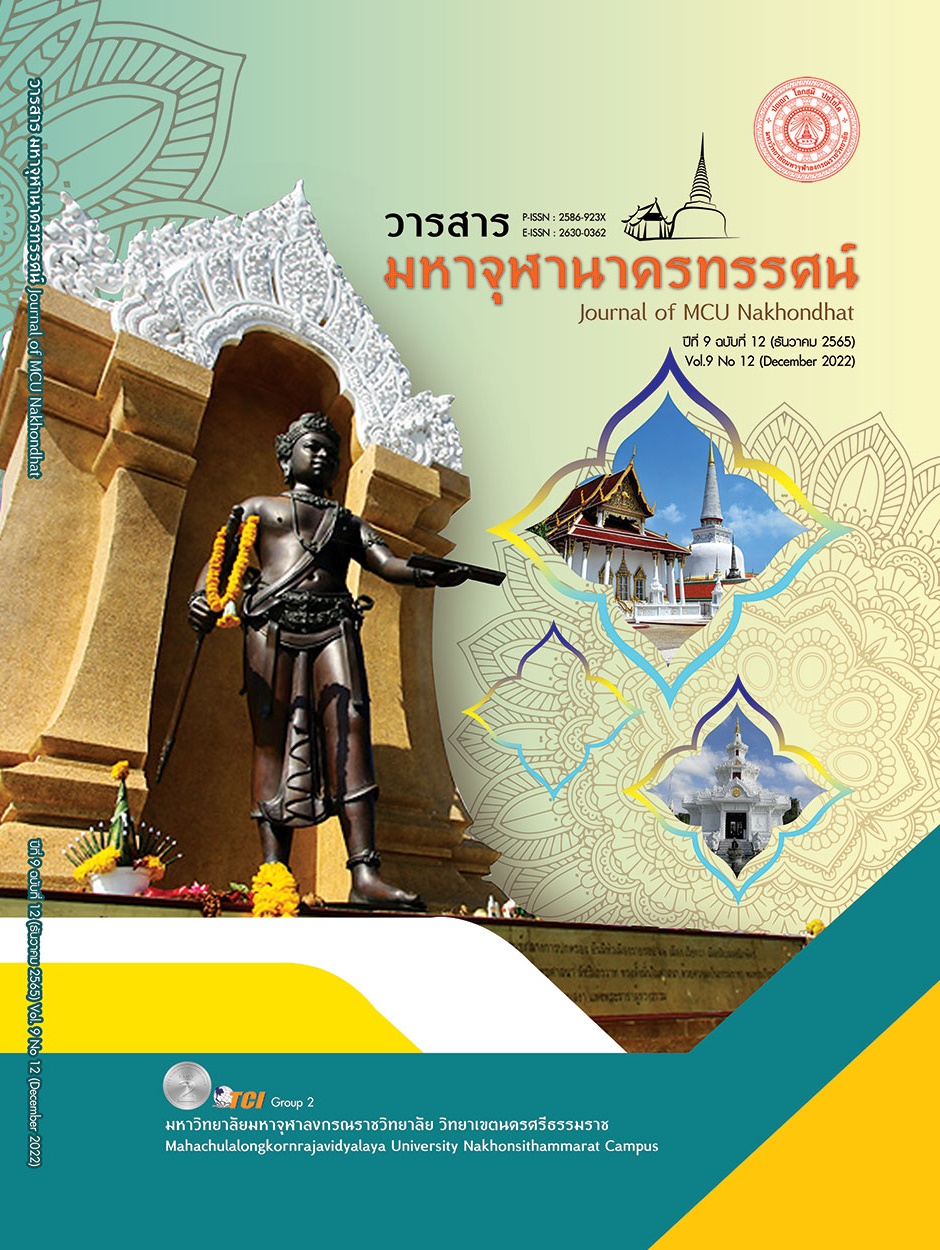A STUDY OF THE CAUSE OF DISEASE BY THE ELEMENTS IN THAI TRADITIONAL MEDICINE SCRIPTURES ACCORDING TO THE FIVE AGGREGATES OF BUDDHISM
Main Article Content
Abstract
This research article aimed to investigate the roles of the four elements affecting the causes of disease based on the five aggregates of Buddhism. Documentary reviews on Thai traditional textbooks and Tripitaka as well as indepth interview with the expertise of Tripitaka were undertaken and analyzing comparative study with medical science. The results revealed that the five aggregates were life consisted of body and mind. The body arose from the fertilization between the father and mother elements, while the mind arose from the death of consciousness to be rebirth in the body of infant in the new world. The body was made up from food which consisted of the four elements: earth, water, wind, and fire. Therefore, it could be concluded that all four elements played a role in building the body through food. In addition, the concept of five aggregates also showed that the role of the four elements which created the body in which was form of the four states, namely Solid state which was structure of the body. Liquid state which was not stable. When blown by the wind element, it became fluid state that transports liquid to nourish the whole body. When food entered the body, it was broken down into nutrients and taken in to the body by biochemical reactions (Metabolism) until it became energy (energy state). Then, the body thus grew along with the consciousness that resided in the body. However, the organs of the body created from the four elements would deteriorate with age. In addition, the old karma inherited with the consciousness would inevitably direct the creation of the body of each infant with different perfection. All in all, the four elements, including the mind, were the causes of the disease.
Article Details

This work is licensed under a Creative Commons Attribution-NonCommercial-NoDerivatives 4.0 International License.
References
บุษบา ประภาสพงศ์ และคณะ. (2552). แพทย์ศาสตร์สงเคราะห์ ภูมิปัญญาทางการแพทย์และมรดกทางวรรณกรรมของชาติ. กรุงเทพมหานคร: คุรุสภาลาดพร้าว.
พระครูสุเมธปทุมาภรณ์. (2564). ธาตุ 4 และการปฏิบัติกรรมฐานในพระพุทธศาสนา. วารสารวิชาการ มจร บุรีรัมย์, 6 (1), 311-322.
พระมหาภิรัฐกรณ์ อํสุมาลี และคณะ. (2563). การคบกันด้วยธาตุของคนในมิติพระพุทธศาสนา. วารสารมหาจุฬานาครทรรศน์, 7 (5), 76-91.
มหาจุฬาลงกรณราชวิทยาลัย. (2539). พระไตรปิฎกภาษาไทย ฉบับมหาจุฬาลงกรณราชวิทยาลัย. กรุงเทพมหานคร: โรงพิมพ์มหาจุฬาลงกรณราชวิทยาลัย.
ยิ่งยง เทาประเสริฐ. (2546). วิถีการดูแลรักษาสุขภาพในระบบการแพทย์พื้นบ้านล้านนา. (พิมพ์ครั้งที่ 3). เชียงใหม่: วนิดาการพิมพ์.
ศิริวรรณ เกตุเพชร. (2558). การศึกษาสมุฏฐานและหลักการรักษาโรคตามหลักทฤษฎีธาตุของพุทธศาสตร์กรณีศึกษาโรคกระเพาะอาหารเรื้อรัง. ใน วิทยานิพนธ์การแพทย์แผนไทยมหาบัณฑิต สาขาวิชาการแพทย์แผนไทย. มหาวิทยาลัยราชภัฏเชียงราย.
ศุภกาญจน์ วิชานาติ และ วัชระ งามจิตเจริญ. (2561). การศึกษาเปรียบเทียบรูปขันธ์กับความจริงทางวิทยาศาสตร์. วารสารพุทธศาสน์ศึกษา จุฬาลงกรณ์มหาวิทยาลัย, 25(2), 7-28.
สุชาติ บุญย์ชญานนท์. (2557). กำเนิดมนุษย์ในทรรศนะพุทธปรัชญา:กรณีอุ้มบุญ. วารสารวนัมฎองแหรกพุทธศาสตรปริทรรศน์, 1 (1), 11-26.
สุวศิน พลนรัตน์. (2558). การศึกษาความเป็นมาในการนำทฤษฎีธาตุของพุทธศาสตร์มาใช้ในการแพทย์แผนไทย. ใน การประชุมสัมมนาวิชาการนำเสนองานวิจัยระดับชาติและนานาชาติ (Proceedings) เครือข่ายบัณฑิตศึกษา. มหาวิทยาลัยราชภัฏภาคเหนือ ครั้งที่ 15.


